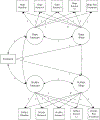Examining Hope as a Transdiagnostic Mechanism of Change Across Anxiety Disorders and CBT Treatment Protocols
- PMID: 32005336
- PMCID: PMC7000132
- DOI: 10.1016/j.beth.2019.06.001
Examining Hope as a Transdiagnostic Mechanism of Change Across Anxiety Disorders and CBT Treatment Protocols
Abstract
Hope is a trait that represents the capacity to identify strategies or pathways to achieve goals and the motivation or agency to effectively pursue those pathways. Hope has been demonstrated to be a robust source of resilience to anxiety and stress and there is limited evidence that, as has been suggested for decades, hope may function as a core process or transdiagnostic mechanism of change in psychotherapy. The current study examined the role of hope in predicting recovery in a clinical trial in which 223 individuals with 1 of 4 anxiety disorders were randomized to transdiagnostic cognitive behavior therapy (CBT), disorder-specific CBT, or a waitlist controlled condition. Effect size results indicated moderate to large intraindividual increases in hope, that changes in hope were consistent across the five CBT treatment protocols, that changes in hope were significantly greater in CBT relative to waitlist, and that changes in hope began early in treatment. Results of growth curve analyses indicated that CBT was a robust predictor of trajectories of change in hope compared to waitlist, and that changes in hope predicted changes in both self-reported and clinician-rated anxiety. Finally, a statistically significant indirect effect was found indicating that the effects of treatment on changes in anxiety were mediated by treatment effects on hope. Together, these results suggest that hope may be a promising transdiagnostic mechanism of change that is relevant across anxiety disorders and treatment protocols.
Keywords: CBT; anxiety; hope; mechanism of change; transdiagnostic.
Copyright © 2019. Published by Elsevier Ltd.
Figures
Similar articles
-
Trajectories of change in well-being during cognitive behavioral therapies for anxiety disorders: Quantifying the impact and covariation with improvements in anxiety.Psychotherapy (Chic). 2020 Sep;57(3):379-390. doi: 10.1037/pst0000283. Epub 2020 Feb 6. Psychotherapy (Chic). 2020. PMID: 32027157 Free PMC article. Clinical Trial.
-
Transdiagnostic versus diagnosis-specific cbt for anxiety disorders: a preliminary randomized controlled noninferiority trial.Depress Anxiety. 2012 Oct;29(10):874-82. doi: 10.1002/da.21974. Epub 2012 Jul 5. Depress Anxiety. 2012. PMID: 22767410 Free PMC article. Clinical Trial.
-
Optimizing Outcomes in Psychotherapy for Anxiety Disorders Using Smartphone-Based and Passive Sensing Features: Protocol for a Randomized Controlled Trial.JMIR Res Protoc. 2024 May 14;13:e42547. doi: 10.2196/42547. JMIR Res Protoc. 2024. PMID: 38743473 Free PMC article.
-
The expanding cognitive-behavioural therapy treatment umbrella for the anxiety disorders: disorder-specific and transdiagnostic approaches.Can J Psychiatry. 2014 Jun;59(6):301-9. doi: 10.1177/070674371405900603. Can J Psychiatry. 2014. PMID: 25007404 Free PMC article. Review.
-
The efficacy of incorporating motivational interviewing to cognitive behavior therapy for anxiety disorders: A review and meta-analysis.Clin Psychol Rev. 2018 Jun;62:1-10. doi: 10.1016/j.cpr.2018.04.004. Epub 2018 Apr 25. Clin Psychol Rev. 2018. PMID: 29727863 Review.
Cited by
-
Therapeutic Community Gardening as a Green Social Prescription for Mental Ill-Health: Impact, Barriers, and Facilitators from the Perspective of Multiple Stakeholders.Int J Environ Res Public Health. 2022 Oct 20;19(20):13612. doi: 10.3390/ijerph192013612. Int J Environ Res Public Health. 2022. PMID: 36294204 Free PMC article.
-
Computer-delivered personalized feedback intervention for hazardous drinkers with elevated anxiety sensitivity: A pilot randomized controlled trial.Behav Res Ther. 2021 Jun;141:103847. doi: 10.1016/j.brat.2021.103847. Epub 2021 Mar 18. Behav Res Ther. 2021. PMID: 33813352 Free PMC article. Clinical Trial.
-
Psychotherapeutic Change Mechanisms and Causal Psychotherapy: Applications to Child Abuse and Trauma.J Child Adolesc Trauma. 2022 Feb 12;15(3):911-923. doi: 10.1007/s40653-022-00438-5. eCollection 2022 Sep. J Child Adolesc Trauma. 2022. PMID: 35958715 Free PMC article.
-
Co-producing principles to guide health research: an illustrative case study from an eating disorder research clinic.Res Involv Engagem. 2023 Sep 20;9(1):84. doi: 10.1186/s40900-023-00460-3. Res Involv Engagem. 2023. PMID: 37730642 Free PMC article.
-
The influence of hope and optimism on trajectories of COVID-19 stress, health anxiety, and wellbeing during the COVID-19 pandemic.J Clin Psychol. 2024 Dec;80(12):2387-2404. doi: 10.1002/jclp.23746. Epub 2024 Oct 8. J Clin Psychol. 2024. PMID: 39380319
References
-
- Alarcon GM, Bowling NA, & Khazon S (2013). Great expectations: A meta-analytic examination of optimism and hope. Personality and Individual Differences, 54(7), 8212013 827. doi: 10.1016/j.paid.2012.12.004 - DOI
-
- Arnau RC (2018). Hope and anxiety In Gallagher MW & Lopez SJ, Oxford Handbook of Hope (pp. 2332013242). New York, NY: Oxford University Press.
-
- Bandura A (1997). Self-efficacy. Englewood Cliffs, NJ: Prentice-Hall.
-
- Barlow DH (2002). Anxiety and its disorders: The nature and treatment of anxiety and panic (2nd ed.). New York, NY: Guilford Press.


